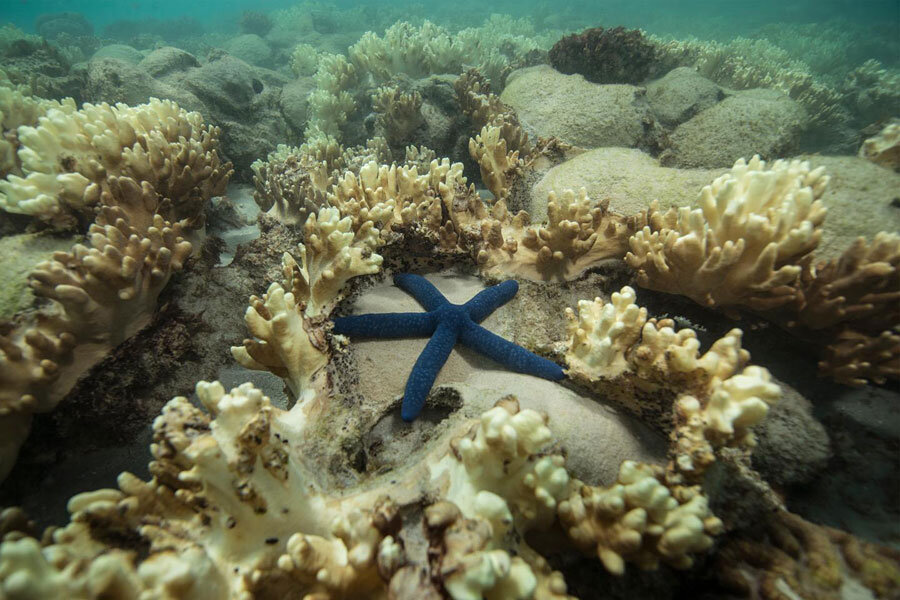Could microbes be 'sentinels' for protecting coral reefs?
Loading...
Coral reefs have their own microbiomes, much like other ecosystems across the globe. And the coral microbiome could hold clues to saving the spectacular reefs.
Globally, reefs are thought to host about 25 percent of marine life. But rapid changes in the oceans stress these ecosystems and lead to dramatic events, like coral bleaching, that scientists worry could be causing permanent damage to the reefs.
Millions of bacteria that live in and on the corals might help mitigate those events, or help the reefs recover, says Tracy Ainsworth, a molecular biologist at James Cook University in Australia. But "we actually don't know a lot about [the coral microbiome]."
Dr. Ainsworth and Ruth Gates, a colleague from the University of Hawai'i at Manoa, synthesize what is known about the relationship between coral reefs and the bacteria that inhabit them in a paper published Thursday in the journal Science. They assert that more research is needed to determine the role those itty-bitty organisms play in protecting or rejuvenating corals under stress.
"We really want to know what are all the pieces of the puzzle that fit together to give corals the best chance" at survival, Ainsworth tells The Christian Science Monitor in a phone interview. "And understanding the microbiome, and particularly the beneficial microbiome, is one piece of that puzzle we need to better understand."
Corals themselves are actually soft little animals. They form a hard skeleton by secreting calcium carbonate that usually attaches to another skeleton to form a large structure, a compact colony of these animals.
Bacteria live inside the coral, in its gut and skeleton, but also live in a mucus layer on top of the animal's tissue. Ainsworth describes that mucus layer as a sort of interface "between the seawater and the actual animal tissue."
The coral microbiome is incredibly diverse. In fact, just one species of coral can host about 170,000 different types of bacteria, Ainsworth says.
"The microbes on the outside of the coral gain nutrients from the coral mucus and may in turn defend the coral from invasive pathogens," Emily Rivest, a marine eco-physiologist at the Bodega Marine Laboratory, University of California, Davis, and who was not an author on the new paper, tells the Monitor in an email. "We still have a lot to learn about the relationship between microbes and corals, but we do know that the community of microbes (how many types are there and who is there) can change depending on the type of coral and the environmental conditions."
"The research community has characterized some of those changes – for example, we know that increasing temperatures often cause a loss of protective bacteria," Koty Sharp, a marine biologist at Roger Williams University who also was not part of the new paper, tells the Monitor in an email. And that could play a role in how corals recover from bleaching events, for example.
When ocean waters become too hot, the symbiotic relationship between corals and the algae that they host breaks down. When corals lose their algae, that's called coral bleaching.
And coral bleaching is becoming a significant problem. In this year's global bleaching event, for example, more than 90 percent of the Great Barrier Reef, the world's largest, has bleached, according to Dr. Rivest.
"Microbes may also play an important role in brokering the relationship between the coral animal and the single-cell algae that it hosts – like a relationship counselor," Rivest says.
"When the algae leave, the coral becomes very vulnerable to stress – from heat, pollution, high light levels, or pathogens. The microbiome may be able to help the coral recover from bleaching," she says. But "if the microbiome is also compromised, pathogens can take hold and the coral may die and never recover."
So scientists need to learn more, all three researchers tell the Monitor.
"The next step is to look through that kind of microbial soup and find which bacteria may be the beneficial ones, understand how they're responding under temperature changes, and what contributions they're making to the coral," Ainsworth says. Understanding all the aspects of that dynamic ecosystem could determine how best to keep reefs as pristine as possible, she says.
"These invisible players drive ecological processes on reefs and within reef animals. They are performing biochemical functions that keep the entire system running smoothly," Dr. Sharp says.
Protecting the corals could mean changing human behavior to prevent rising ocean temperatures, or to reduce pollution that might stress the marine ecosystem.
The microbes could provide a way to take a reef's temperature, so to speak. "Ultimately, it would be great to be able to swab a coral and get an idea of its health from the microbes found there. It may give us more time to protect the coral during stressful episodes, before they bleach for example," Rivest says.
Or, she adds, there may be a way to help corals recover from stressful events. Perhaps "we may be able to provide corals with probiotics during warm events or after bleaching events."
The coral microbiome may be "like a guard, an early warning, and a level of protection that we may take for granted," Ainsworth says. In other words, a sort of "sentinel."








